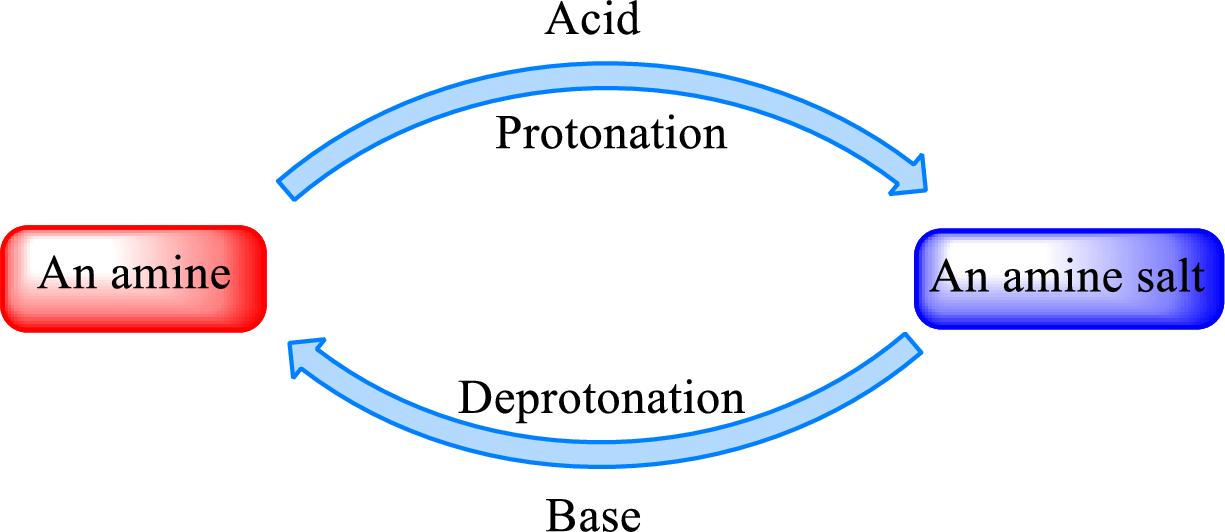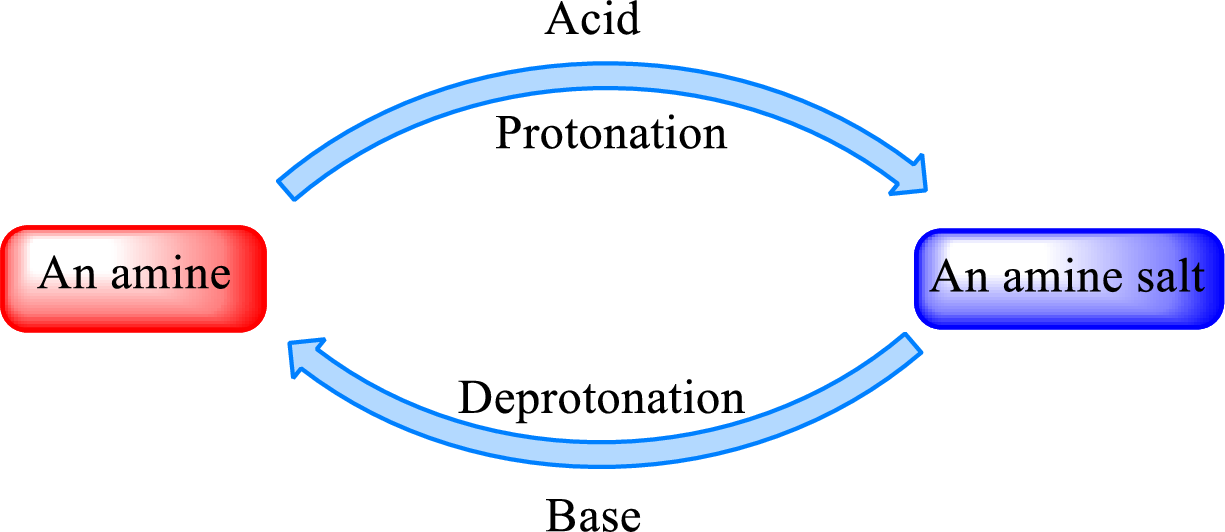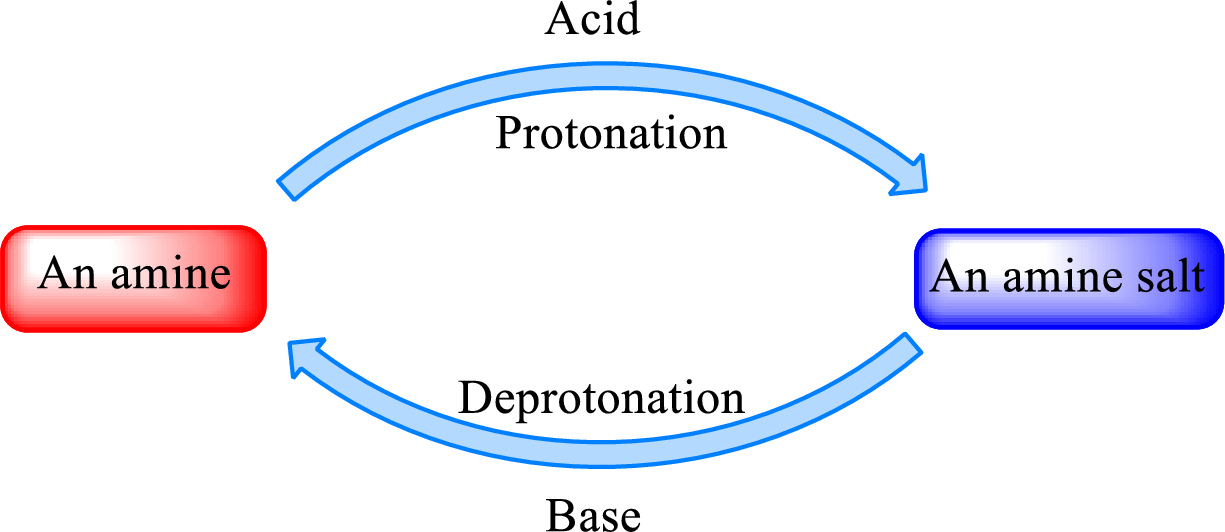
Concept explainers
(a)
Interpretation:
“Parent” amine can be regenerated from the given salt or not has to be indicated.
Concept Introduction:
Quaternary ammonium salt is the one that has four carbon atoms attached to the nitrogen atom. This is formed by the reaction of tertiary amine with
Neutralization reaction is the one that takes place between an acid and a base to give salt as product. As
When a strong base is added to the amine salt, the parent amine can be obtained. This is a reverse reaction of the amine salt formation reaction. These reactions can be represented as shown below,

Quaternary ammonium salt does not give the “parent” amine when treated with a strong base as there is no possibility of deprotonation to take place.
(b)
Interpretation:
“Parent” amine can be regenerated from the given salt or not has to be indicated.
Concept Introduction:
Quaternary ammonium salt is the one that has four carbon atoms attached to the nitrogen atom. This is formed by the reaction of tertiary amine with alkyl halide in presence of a strong base.
Neutralization reaction is the one that takes place between an acid and a base to give salt as product. As amines are bases due to the amino group in it, the reaction with inorganic acid or carboxylic acid gives salt as product. The salt formed is an amine salt. Proton is donated from the acid to the nitrogen atom which acts as a proton acceptor. In simple words, it can be said that in an amine‑acid reaction, the acid loses a hydrogen ion and amine gains a hydrogen ion.
When a strong base is added to the amine salt, the parent amine can be obtained. This is a reverse reaction of the amine salt formation reaction. These reactions can be represented as shown below,

Quaternary ammonium salt does not give the “parent” amine when treated with a strong base as there is no possibility of deprotonation to take place.
(c)
Interpretation:
“Parent” amine can be regenerated from the given salt or not has to be indicated.
Concept Introduction:
Quaternary ammonium salt is the one that has four carbon atoms attached to the nitrogen atom. This is formed by the reaction of tertiary amine with alkyl halide in presence of a strong base.
Neutralization reaction is the one that takes place between an acid and a base to give salt as product. As amines are bases due to the amino group in it, the reaction with inorganic acid or carboxylic acid gives salt as product. The salt formed is an amine salt. Proton is donated from the acid to the nitrogen atom which acts as a proton acceptor. In simple words, it can be said that in an amine‑acid reaction, the acid loses a hydrogen ion and amine gains a hydrogen ion.
When a strong base is added to the amine salt, the parent amine can be obtained. This is a reverse reaction of the amine salt formation reaction. These reactions can be represented as shown below,

Quaternary ammonium salt does not give the “parent” amine when treated with a strong base as there is no possibility of deprotonation to take place.
(d)
Interpretation:
“Parent” amine can be regenerated from the given salt or not has to be indicated.
Concept Introduction:
Quaternary ammonium salt is the one that has four carbon atoms attached to the nitrogen atom. This is formed by the reaction of tertiary amine with alkyl halide in presence of a strong base.
Neutralization reaction is the one that takes place between an acid and a base to give salt as product. As amines are bases due to the amino group in it, the reaction with inorganic acid or carboxylic acid gives salt as product. The salt formed is an amine salt. Proton is donated from the acid to the nitrogen atom which acts as a proton acceptor. In simple words, it can be said that in an amine‑acid reaction, the acid loses a hydrogen ion and amine gains a hydrogen ion.
When a strong base is added to the amine salt, the parent amine can be obtained. This is a reverse reaction of the amine salt formation reaction. These reactions can be represented as shown below,

Quaternary ammonium salt does not give the “parent” amine when treated with a strong base as there is no possibility of deprotonation to take place.
Trending nowThis is a popular solution!

Chapter 17 Solutions
EBK GENERAL, ORGANIC, AND BIOLOGICAL CH
- Following are Fischer projections for a group of five-carbon sugars, all of which are aldopentoses. Identify the pairs that are enantiomers. CHO сно H-C- OH H-C-OH H-C- OH но-с — н н-с—он но- ČHOH ČH,OH сно CHO Н-с—он но—с— н H-C- OH H-C-OH но—с—н Н-с—он ČHOH ČH,OH сно сно н-с—он но—с —н но—с— н но -с — н H-C- OH но- C-H ČH,OH ČH,OHarrow_forwardFollowing are Fischer projections for a group of five-carbon sugars, all of which are aldopentoses. Identify the pairs that are enantiomers and the pairs that are epimers. (The sugars shown here are not all of the possible five-carbon )arrow_forwardPenicillin G is a natural antibiotic that is useful for treating infections caused by Gram positive bacteria. What is the functional benefit of the semi-synthetic antimicrobials carbenicillin and ampicillin, generated by chemical modification of the R group so their R groups each are a bit different than the R group seen with penicillin G?arrow_forward
- Following are Fischer projection for a group of five carbon sugars,all of which are aldopentoses. Identify the pairs that are enantiomers and the pairs that are epimers.(The sugar shown herebare not all of the possible five carbon sugars.)arrow_forwardPropanamide and methyl acetate have about the same molar mass, both are quite soluble in water, and yet the boiling point of propanamide is 486 K, whereas that of methyl acetate is 330 K. Explain.arrow_forwardFor A, B, C, D, E, F, identify the circled functional groups and linkages in the compound in the picture.arrow_forward
- A decapeptide has the following acid composition; Al2,Arg,Cys,Glu,Leu,Phe,Val Partial hydrolysis yield the following tripeptides; Cys-Glu-Leu+Gly-Arg-Cys+Leu-Ala-Ala+Lys-Val-Phe-Gly Reaction of the decapeptide with 2,4-dinitrofluorobenzene yields 2,4-dinitrophenylysine. From the experimental data, deduce the primary structure of the decapeptide. Suggest a scheme you will follow to synthesize the dipeptide Ala-Gly.arrow_forwardFollowing are Fischer projections for a groupof five-carbon sugars, all of which are aldopentoses. Identify thepairs that are enantiomers and the pairs that are epimers. (Thesugars shown here are not all of the possible five-carbon sugars.)arrow_forwardCocaine (C17H21O4N; Figure 2) is a natural substance found in leaves of the coca plant, which have been used for centuries as a local anaesthetic and stimulant. Illegal cocaine arrives in the USA either as the pure compound or as the hydrochloride salt (C17H21O4NHCl). At 25oC, the salt is very soluble in water (2.50 kg/L), but pure cocaine is much less so (1.70 g/L)What is the maximum amount of the salt (in gram) that can dissolve in 50.0 mL of water?When a 25 mL aqueous solution that contains 62.50 g of the salt is treated with NaOH, the salt is converted to pure cocaine. How much water (in litres) is needed additionally to dissolve the formed pure cocaine?arrow_forward
- Which form of aspartic acid in Problem 18.54 is the zwitterion? What is the pI for the zwitterion?arrow_forwardThe amino acid glycine is often used as an ingredient in buffers for biochemistry experiments. The amino group of glycine has a pKa of 9.6. Glycine exists in either a protonated form (-NH3+) or a free base (-NH₂). a) In what pH range can glycine be used as an effective buffer? b) In a 0.1M solution of glycine at pH 9.0, what fraction has its amino group in the protonated form? c) When 99% of the glycine is in the protonated from, what is the numerical relation between the pH of the solution and the pKa of the amino group?arrow_forwardSpermaceti, a fragrant substance isolated from sperm whales, was commonly used in cosmetics until it was banned in 1976 to protect the whales from extinction. Chemically, spermaceti is cetyl palmitate, the ester of palmiticacid with cetyl alcohol (the straight-chain 16-carbon alcohol). Draw the structure of spermaceti.arrow_forward
 Human Anatomy & Physiology (11th Edition)BiologyISBN:9780134580999Author:Elaine N. Marieb, Katja N. HoehnPublisher:PEARSON
Human Anatomy & Physiology (11th Edition)BiologyISBN:9780134580999Author:Elaine N. Marieb, Katja N. HoehnPublisher:PEARSON Biology 2eBiologyISBN:9781947172517Author:Matthew Douglas, Jung Choi, Mary Ann ClarkPublisher:OpenStax
Biology 2eBiologyISBN:9781947172517Author:Matthew Douglas, Jung Choi, Mary Ann ClarkPublisher:OpenStax Anatomy & PhysiologyBiologyISBN:9781259398629Author:McKinley, Michael P., O'loughlin, Valerie Dean, Bidle, Theresa StouterPublisher:Mcgraw Hill Education,
Anatomy & PhysiologyBiologyISBN:9781259398629Author:McKinley, Michael P., O'loughlin, Valerie Dean, Bidle, Theresa StouterPublisher:Mcgraw Hill Education, Molecular Biology of the Cell (Sixth Edition)BiologyISBN:9780815344322Author:Bruce Alberts, Alexander D. Johnson, Julian Lewis, David Morgan, Martin Raff, Keith Roberts, Peter WalterPublisher:W. W. Norton & Company
Molecular Biology of the Cell (Sixth Edition)BiologyISBN:9780815344322Author:Bruce Alberts, Alexander D. Johnson, Julian Lewis, David Morgan, Martin Raff, Keith Roberts, Peter WalterPublisher:W. W. Norton & Company Laboratory Manual For Human Anatomy & PhysiologyBiologyISBN:9781260159363Author:Martin, Terry R., Prentice-craver, CynthiaPublisher:McGraw-Hill Publishing Co.
Laboratory Manual For Human Anatomy & PhysiologyBiologyISBN:9781260159363Author:Martin, Terry R., Prentice-craver, CynthiaPublisher:McGraw-Hill Publishing Co. Inquiry Into Life (16th Edition)BiologyISBN:9781260231700Author:Sylvia S. Mader, Michael WindelspechtPublisher:McGraw Hill Education
Inquiry Into Life (16th Edition)BiologyISBN:9781260231700Author:Sylvia S. Mader, Michael WindelspechtPublisher:McGraw Hill Education





